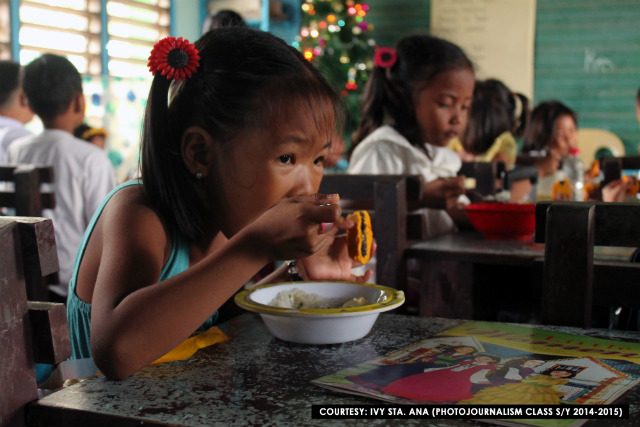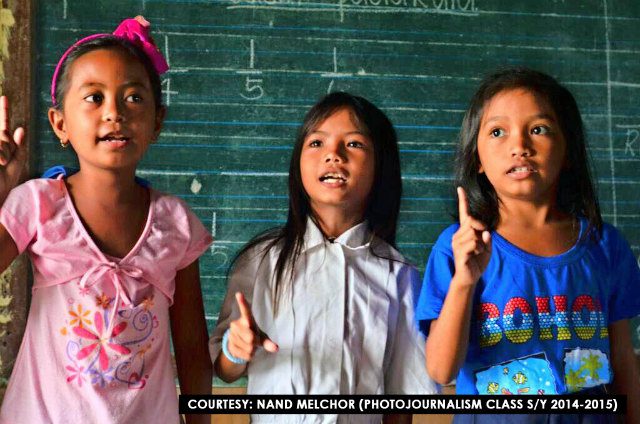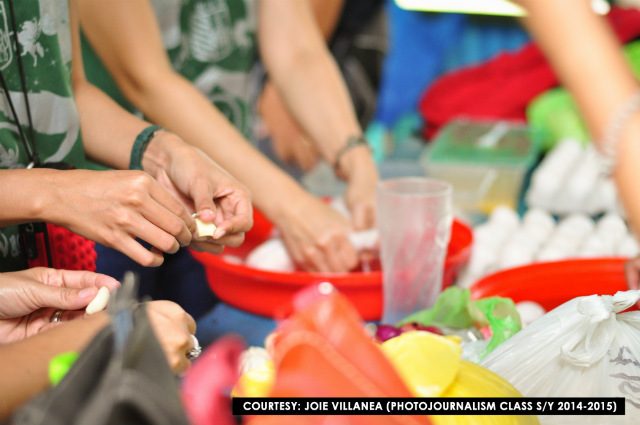SUMMARY
This is AI generated summarization, which may have errors. For context, always refer to the full article.

MANILA, Philippines – Hunger is still a perennial problem in Third World countries like the Philippines, but there are ways to put an end to it.
For the Center for Community Development (CCD) of the Ateneo de Naga University (ADNU) in Bicol, this means decreasing the number of hungry school children one meal at a time.
CCD, ADNU’s social involvement arm, conducted its latest Supplemental Feeding Program in 5 of the university’s partner schools from October 2014 to March 2015.
It was made possible by the collaborative efforts of CCD, ADNU’s College of Nursing, barangay and school officials, and the Kristong Hari Foundation, with support from Philippine Hilfe.
According to the feeding program’s impact assessment report sent to Rappler, a total of 416 children aged 0 to 12 from Barobaybay Elementary School, Ponong Integrated School, Fundado Elementary School, San Nicolas Elementary School, and Bal-Flor Elementary School and their surrounding areas in Camarines Sur were given a free meal thrice a week during school break periods.
The menu, developed in consultation with barangay nutritionists, included snack meals like champorado, sweet mongo, macaroni soup, and arroz caldo.
“Food is a basic human right. You need the food to keep things going. You need the energy to fight the problems of the world,” said CCD Director Elmer Sto Domingo when asked about the rationale behind the program.
According to him, a hungry child will not be able to participate in classroom discussions and school activities well. (READ: Learning on an empty stomach)
“Through the small [efforts of our feeding program], they are given the strength to at least continue fighting.”
Step by step

Sto Domingo described the situation in some of ADNU’s partner communities for the feeding program, emphasizing how the agricultural circumstances in the areas make it difficult for parents to provide their children nutritious meals every day.
“May isang area kami na ang income or livelihood of majority of the families ay sa mga nipa, so their income depends on how many nipa shingles they can produce in a day,” Sto Domingo shared, saying that the average daily income of P120 a nipa shingle maker gets is usually inadequate for a family’s expenses in a day.
(We have an area where the main source of livelihood for majority of the families is nipa palm, so their income depends on how many nipa shingles they can produce in a day.)
“Sometimes, they (the children) will go to school very hungry. ‘Yung iba walang makain (The others even have nothing to eat),” he said. (READ: Why you should care about stunting)
“So with the feeding program…even the parents themselves are benefitting from [it].”
Sto Domingo said the beneficiaries of the feeding program were children identified as malnourished by barangay and school officials. The financial situation of the children’s families was also taken into consideration.
ADNU provided the ingredients and the children’s parents were the ones who cooked the meals. The teachers and nutrition coordinators, meanwhile, were tasked to monitor the attendance of beneficiaries and to oversee the safekeeping of the food supplies. The children were also weighed monthly by their teachers or parents. (READ: Lend a hand: Help kids reach their 5th birthday)
While the feeding program beneficiaries are given priority during food distribution, Sto Domingo said other children from the school and the barangay were given food as long as they have extra meals to spare.
“We don’t discriminate… Everybody can get their share,” Sto Domingo said.
According to CCD’s report, 64.9% of 416 children gained weight by the end of the feeding program. CCD’s report also noted that teachers noticed a decrease in school absences and an increase in classroom participation among the beneficiaries.
“‘Yung mga bata, mas masipag pumasok,” added Sto Domingo. (They children became more eager to go to school.)
In the long run

Undeniably, there is still much to be done to achieve zero hunger in the Philippines, with around 7.9 million Filipino families still saying they are poor in terms of food.
According to Sto Domingo, a former paralegal for a national farmers’ organization and volunteer for Jesuit Volunteers Philippines, different sectors should work together to provide concerned communities with alternative livelihood programs. He said farmers should also be given rights to their own lands. (READ: PH agriculture: Why is it important?)
“Hunger is, I think, hindi masosolusyunan hanggang [di] makakaabot talaga ‘yung assistance sa mga tao,” he said. (Hunger will not be solved if the assistance does not reach the people.)
However, Sto Domingo thinks that projects like school feeding programs, though small, can potentially benefit more communities.
This sentiment was echoed by ADNU senior elementary education major John Peter Dado, the external vice president for CCD Voltz, a student organization that assists in some of CCD’s activities.
“Pag tumutulong kami, hindi lang sila (partner communities) ang tinutulungan namin (When we volunteer, it’s not only the partner communities we end up helping),” said Dado, who added that volunteering convinced him that he really wanted to pursue teaching after graduation.
He added, “Pag nagre-reach out kami sa kanila, mas grabe ang nakukuha naming learnings.” (When we reach out to them, we learn so much more in return.) – Rappler.com
Add a comment
How does this make you feel?
There are no comments yet. Add your comment to start the conversation.